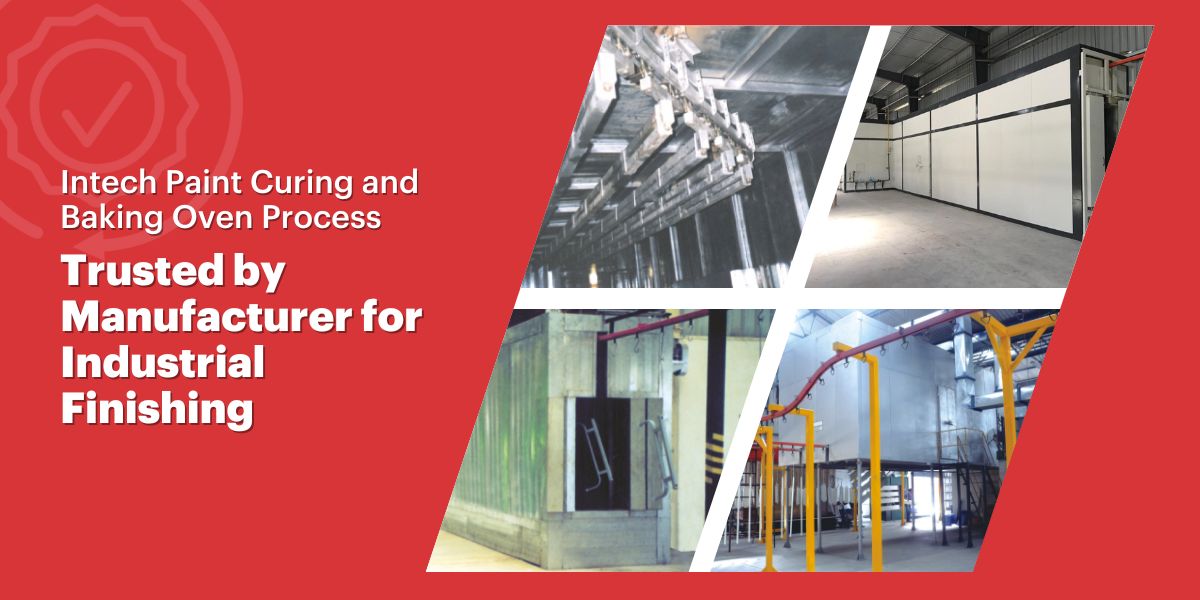1. What is The Paint Baking Oven?
Paint curing ovens also known as paint drying ovens or baking ovens are industrial systems designed to expose coated parts to controlled heat and airflow, accelerating paint drying and ensuring durable, uniform finishes.
These ovens are available in batch (single load) or continuous (conveyorized) formats to match production volume and workflow needs .
2. Why Choose Industrial Paint Baking Oven?
Faster Drying: High-precision ovens achieve ideal curing temperatures within minutes, reducing drying time by up to 35%
Improved Durability: Heat induces cross-linking in paints, boosting hardness, adhesion and resistance to wear.
Enhanced Finish Quality: Uniform temperature and airflow eliminate common coating defects like orange peel, drips or uneven gloss.
Eco-Friendly & Safe: Integrated exhaust systems remove VOCs (Volatile Organic Compounds) and solvents, promoting a healthier environment.
3. Core Components of Paint Curing Oven
| Component | Function |
| Oven Enclosure | Insulated chamber (batch/continuous) with sealed doors or infeed/outfeed openings. |
| Heating Unit | Gas, electric, infrared or clean-heated air system, precise temperature ramp & soak via PID control |
| Recirculating Air System | Fans and air plenums ensure even temperature distribution throughout |
| Supply Air System | Introduces fresh, conditioned air to maintain oven efficiency and variable heat profiles |
| Exhaust System | Extracts fumes and excess moisture, aiding environmental compliance |
| Control Panel / Safety Systems | Programmable interfaces with ramp/soak, timers, alarms, maintenance alerts |
4. Step-by-Step Process in an Intech Paint Curing Oven
1. Pre-treatment: Thorough cleaning, degreasing and optional priming ensure optimal coating adhesion.
2. Loading: Hang or position parts onto conveyor or batch racks as per design specs.
3. Ramp & Soak Heat Cycle:
i) Ramp: Gradually raise temperature to target setpoint (typical range 140–200 °F / 60–90 °C for wet coatings; up to 400 °F / 205 °C for high-temp paints)
ii) Soak: Maintain set temperature long enough to fully cure chemical cross-linking.
4. Airflow Management: Balanced recirculation ensures uniform finish with no hot/cold zones.
5. Exhaust Phase: Removes solvent vapors and reduces risk of combustion or contamination.
6. Cooling & Unload: Controlled cooldown to room temperature before part removal or further assembly.
Types of Paint Baking Oven
1. Batch Ovens – Ideal for small to medium runs where varied cycle parameters are needed
2. Continuous Conveyor Ovens – More efficient for high-volume applications; build around conveyor speed.
3. Specialty Configurations:
- Ground Mounted: Floor level access convenient for heavy parts.
- Camelback: Arched top ensures superior airflow and even heat distribution .
6. Selecting the Right Oven for Your Business
When choosing a paint curing oven, consider:
- Production Throughput: Total cycle time × batch size determines continuous vs batch.
- Substrate & Part Dimensions: Floor space, conveyor width and oven height matter.
- Coating Chemistry: Waterborne, solvent-borne, powder or high-temp require specific temperature profiles.
- Energy Source: Electric is cleaner gas is cost-effective infrared is high-speed/batch-focused.
- Compliance Needs: Fume capture and temperature control systems for VOC and emission regulations.
7. Intech Surface Coating’s Oven Solutions
At Intech Surface Coating, we offer end-to-end expertise:
- Custom engineered ovens electric, gas, IR designed for your throughput and product mix.
- Advanced airflow and temperature control for uniformity and repeatability ideal for industrial use.
- Integrated safety features: exhaust, programmable controls, diagnostic systems, and more.
- Complete project delivery from concept to commissioning and after-sales maintenance.
8. Maintenance & Safety Best Practices
- Routine Calibrations: Keep oven temperature and airflow systems tuned for consistency.
- Filter & Exhaust Checks: Replace clogged filters and inspect ducts to maintain fume extraction and safety.
- Preventive Maintenance Plans: Proactively service burners, fans, seals and electrical systems to prevent downtime.
- Operator Training: Ensure staff are trained in alarms, controls and emergency shut-off procedures.
Why This Matters for Your Business
- Investing in high-quality paint baking ovens translates to reduction in cycle times, improvement in product durability and consistent high-quality finishes.
- With shorter lead times and higher first-pass yields, you’ll boost plant throughput and profitability.
- At the same time, Intech’s ovens provide environmental compliance with integrated exhaust and VOC controls.
Key Takeaways
- Paint curing ovens use heat + airflow to cross-link coating molecules for harder, longer-lasting finishes.
- Composed of heating, airflow, exhaust and control units batch or conveyor types.
- Proper specs ensure VOC safety, color consistency and uniform adhesion.
- Intech’s customized ovens support your production needs with solid engineering and service support.
FAQ for Powder Baking Ovens
- How Does a Powder Baking Oven Work?
Ans: The oven heats coated parts uniformly using convection, infrared, or electric heating systems. The powder coating melts, flows, and cures into a smooth finish during the baking cycle (usually 10-30 minutes). What Temperature is Required for Powder Curing?
Ans: Most powders cure at 160-200°C, but exact temperatures depend on the powder type and substrate material. Always follow the manufacturer’s specifications.Can Powder Baking Ovens Be Customized?
Ans: Yes! Ovens can be tailored for size, heating method, automation, and energy source (electric, gas or hybrid). Custom options include PLC controls, exhaust systems, and multi-zone heating.


